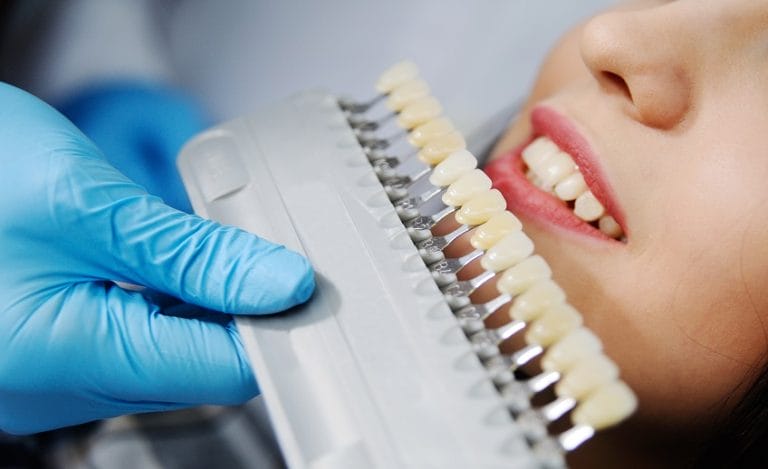Dental crowns are a way to restore teeth that have been damaged. Crowns are tooth-shaped caps placed on top of the damaged teeth and are done to strengthen the tooth or restore it to its natural shape and size. Dental crowns are often used when a patient has suffered from tooth decay, which causes teeth to become extremely brittle, sensitive, discolored, or misshapen. They can also be done after an injury or for cosmetic reasons. Dental crowns come in many different shapes and materials, so it is important to talk to your dentist about the best option for you.
According to the American Dental Association, A crown can help strengthen a tooth with a large filling when there isn’t enough tooth remaining to hold the filling. Crowns can also be used to attach bridges, protect a weak tooth from breaking or restore one that’s already broken. A crown is a good way to cover teeth that are discolored or badly shaped. It’s also used to cover a dental implant.
Types of dental crowns
There are many different types of dental crowns that your dentist will choose from, including:
Ceramic Crowns:
Ceramic crowns are made of porcelain or another type of ceramic, and they can either be tooth-colored or white. They are the most natural-looking option, but they can chip if exposed to extreme hot or cold temperatures. Ceramic crowns also require more expensive lab fees due to their intricate design.
Porcelain crowns:
Porcelain crowns are made with porcelain fused to metal, which helps them better withstand chewing forces. These crowns can also be tooth-colored or white, and they look very natural in your mouth. They can be made as large or small as necessary for any size mouth, but porcelain does not hold up very well if you grind down on it during sleep.
Resin:
Crowns made out of resin are generally cheaper than other types of crowns. However, they tend to wear out over time.
Metal:
Metal crowns are very strong and great for restoring teeth that have been severely damaged. However, metal is more visible than other dental crowns, so it may not look as natural when placed on a tooth.
There are pros and cons to choosing any type of dental crown. The best choice will ultimately depend on your specific needs and desires. Talk to your dentist to know the type that is best for you.
Procedure for installing dental crowns
The procedure for installing crowns requires two dental visits. During the first visit, your dentist will start by numbing the area with a local anesthetic, which takes about 30-45 minutes to take effect. Then they use specific instruments to cut away all of the damaged enamel and prepare your tooth for receiving its new cover. Once that is complete, they place the temporary crown over your tooth until it can be cemented properly into place at another appointment.
The next visit only takes about 15-20 minutes because you do not need any anesthesia during this process. Your dentist will first take out the temporary crown and prepare your tooth for cementation. They will then place a permanent dental crown over it that is custom-made just for you to fit comfortably in your mouth. After holding it into position with an adhesive material or metal clasp until this has dried completely, they will take out all of the temporary tools used during the procedure and send you on your way.
Once the tooth crown installation procedure is done, you might take some time to get used to the feeling of your new tooth crown. It may take a few days before you get used to eating and talking with it, so be patient during this time as you adjust.
Risks involved with dental crowns
Dental crowns are very safe, but there are a few risks involved. Your dentist can discuss them with you before your procedure begins so that you have all of the information necessary to make a fully informed decision. Some of the risks include:
Infection: Infection is rare, but it can happen if you do not follow your dentist’s instructions for post-procedure care.
Nerve damage: This is also an uncommon side effect, but it can happen if your dentist accidentally nicks or cuts the nerve in your mouth when they are preparing your tooth for dental crown placement.
Hypersensitivity: This can be a common side effect with some types of crowns, but it tends to subside over time. You may experience heat and cold sensitivity with a new crown. To take care of that, your dentist might recommend that you brush your teeth with toothpaste made for sensitive teeth.
Loose crown: Your dental crown can become loose over time, which can expose your tooth to decay-causing bacteria. If your crown feels loose, or even falls off, contact your dentist.
Caring for dental crowns
Generally, dental crowns do not require any special treatment. A dental crown can last for up to 15 years, depending on the type of crown and the wear and tear you expose it to. To keep it lasting, you should follow oral hygiene practices and avoid habits such as chewing ice, grinding your teeth, biting your nails, and using your teeth as a tool to open packaging.
Dental crowns are excellent for restoring teeth that have been severely damaged. When applied correctly by experienced dental professionals, dental crowns will improve your smile’s appearance and maintain the health of your mouth. Since there are many options for dental crowns, the best choice will ultimately depend on your specific needs and desires. Talk to your dentist to know the option that is best for you.



